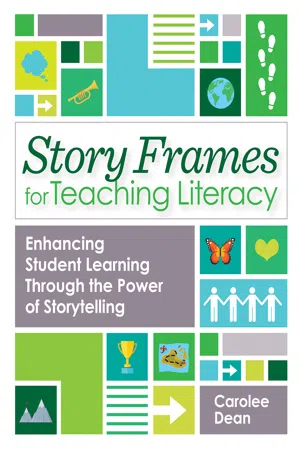
Story Frames for Teaching Literacy
Enhancing Student Learning Through the Power of Storytelling
- 240 pages
- English
- ePUB (mobile friendly)
- Available on iOS & Android
Story Frames for Teaching Literacy
Enhancing Student Learning Through the Power of Storytelling
About this book
Mastering the art of storytelling isn't just a goal for professional writers. Analyzing and creating stories can boost critical literacy skills for all learners—and this comprehensive resource will show teachers and SLPs how.
Aligned with the science of reading, this innovative guidebook reveals how to unlock literacy and learning skills by captivating K–12 students with the power of stories: how they're structured, how they reflect and change lives, and how students can create their own original narratives. Using dozens of diverse fiction and nonfiction books as vivid examples, you'll discover how to teach 12 key story elements ( Story Frames ) in dynamic, fun, and highly visual ways, including Quick Draws, storyboards, and icons that make narrative structure easy to grasp. Then you'll get in-depth guidance on how to use knowledge of story structure to build core literacy skills—from oral language to reading comprehension—and empower students to write their own personal stories in a variety of genres.
Enhanced with more than 35 adaptable lesson plans and a complete package of online support materials, Story Frames is an accessible pathway to structured literacy that any educator can start using right away. You'll use it year after year to strengthen your students' skills and instill a lifelong love of reading and writing in every learner.
STORY FRAMES WILL HELP YOU
- Get started with structured literacy in a fun and engaging way
- Build core literacy skills, including phonological awareness, reading comprehension, oral language, vocabulary, grammar, syntax, narrative development, and expository writing
- Strengthen your existing curriculum with flexible lesson plans and activities aligned with the science of reading
- Effectively teach narrative structure to both struggling and advanced learners
- Teach students in any setting, with practical tips for teletherapy and virtual instruction
- Boost executive function skills by making the writing process comprehensible, meaningful, and manageable
- Empower students with and without disabilities by giving them the tools to tell their own stories
ONLINE MATERIALS: Implement Story Frames effectively with a full package of downloadable materials, including sample storyboards and templates, 40+ handouts and worksheets, game cards, slide decks to use in instruction, 30+ sample story analyses of books for children and young adults, and brief literature guides for applying Story Frames to picture books and to chapter books and novels.
Frequently asked questions
- Essential is ideal for learners and professionals who enjoy exploring a wide range of subjects. Access the Essential Library with 800,000+ trusted titles and best-sellers across business, personal growth, and the humanities. Includes unlimited reading time and Standard Read Aloud voice.
- Complete: Perfect for advanced learners and researchers needing full, unrestricted access. Unlock 1.4M+ books across hundreds of subjects, including academic and specialized titles. The Complete Plan also includes advanced features like Premium Read Aloud and Research Assistant.
Please note we cannot support devices running on iOS 13 and Android 7 or earlier. Learn more about using the app.
Information
 |
Keep this resource on hand for a quick summary of the Common Core State Standards for children’s narrative development: Common Core State Standards expectations for narrative writing, Grades 1–8. |
Table of contents
- Cover
- Title Page
- Copyright
- Contents
- About the Downloads
- About the Author
- About the Contributors
- Acknowledgments
- Introduction
- Story Frames Analyses of Picture Books
- Story Frames Analyses of Chapter Books and Novels
- Section I: Your Story Frames Toolbox
- Section II: Using Story Frames to Build Literacy Skills
- Section III: Shaping Writers, Shaping Lives: The Power of Personal Narrative
- References
- Index
- Back Cover